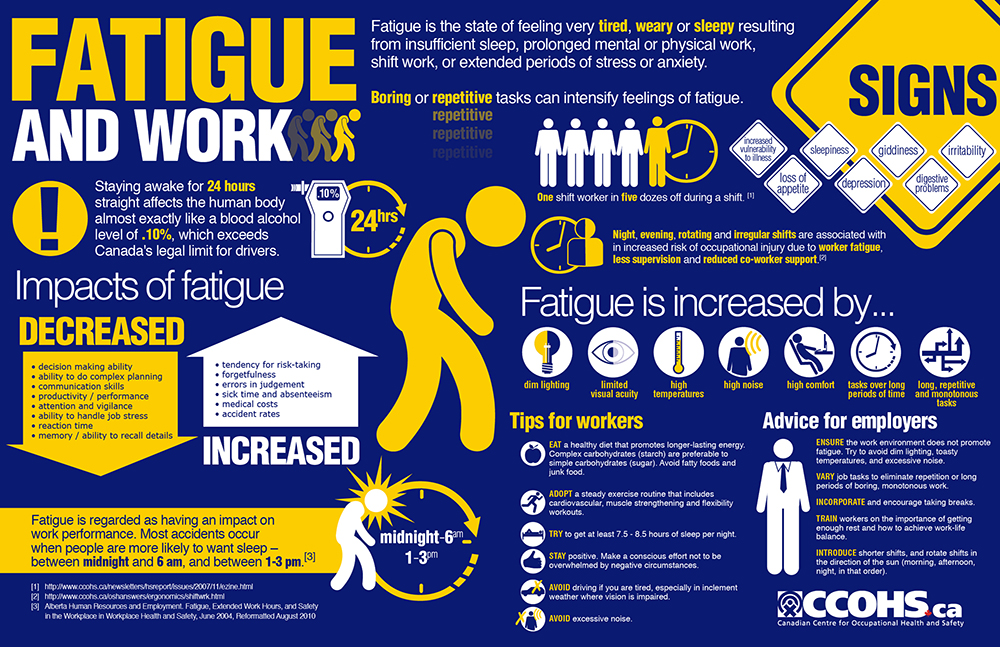
WORKPLACE FATIGUE AWARENESS

According to The Conference Board of Canada, almost 30% of Canadian workers report being fatigued most days or every day during a typical work week. Those most at risk work the night shift, long shifts or irregular shifts. When you aren’t able to give your body and mind enough rest, workplace fatigue can quickly set in. And when an accident happens in your workplace, the consequences are much more severe than sending an email to the wrong recipient. A mistake on an oil rig or a manufacturing assembly line could cause serious injuries and catastrophic harm to the environment.
Fatigue is much more than feeling sleepy; it is a physical, mental or social impairment that includes tiredness, sleepiness, reduced energy and increased effort needed to perform tasks at a desired level. Fatigue can be caused by the time of day, sleep deprivation or prolonged time spent on tasks that are physically or mentally demanding.
Possible Consequences
What happens when fatigued employees are on the job? They risk:
- Making mistakes, which affects product/project quality
- Causing accidents that may result in bodily injuries
- Putting others in harm’s way, including coworkers and the general public
- Decreasing productivity and losing work hours
- Cutting corners to complete a task, which could mean regulatory violations
- Having their coworkers not feel safe
Tips for Employers
According to PEO Canada, it is estimated that fatigue costs employers $330 million annually in lost productivity. Thankfully there are ways to reduce the risk of workplace fatigue.
Irregular, night or long shifts are commonplace in areas such as construction, mining and manufacturing. Sometimes it is difficult to avoid rotating shifts, but studies have shown that regular, predictable schedules are better for productivity and wellbeing. If possible, try to limit shifts to 8-10 hours. The Canadian Centre for Occupational Health and Safety (CCOHS) recommends that employees are given adequate time to recover between shifts.
Fatigue can also set in when employees are performing a repetitive task for long stretches. The average worker loses 25% of their productivity when standing on hard surface flooring. Anti-fatigue floor mats have a raised surface that can increase productivity and reduce back, leg and feet discomfort.
Another preventative measure is to remind employees how important sleep is. Safety managers and supervisors can share studies on how many hours of sleep are needed to perform specific tasks. Making sleep part of a corporate wellness program will also demonstrate how much you value employee wellbeing.
Tips for Employees
If your work schedule falls under the categories of shift work or extended hours, you may suffer from fatigue. According to Statistics Canada, the most common health complaint of shift workers is lack of sleep. What can you do? Listen to your body. If you find that you’re struggling to concentrate or making mistakes on the job, think about your sleeping habits. Are you getting seven or more hours of sleep? Sore muscles, loss of appetite and frequent headaches can be a sign of not enough sleep.
Taking on-the-job breaks can help you recharge. And when you’re on break, try to unplug and relax your mind and body. If you work night shifts, keep the same sleep schedule even on your days off to maintain a routine.
Be Aware
Whether you’re a company owner whose bottom line may be affected or a shift worker who takes pride in their job, workplace fatigue can be a problem. Employees who get enough sleep each night and limit long shifts are more alert and safe on the job. Employers who are vigilant about recognizing fatigue can offer solutions so that overall productivity is not impacted.
PEOPLE YOU CAN COUNT ON®
Learn how we make your life easier with brand-building solutions to keep your employees and facilities looking their best.

.png)


